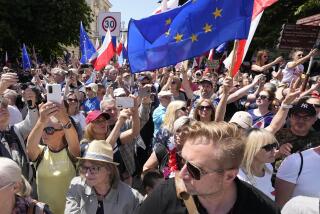Thousands Join Hands in Baltic States Protest
- Share via
VILNIUS, Soviet Union — Hundreds of thousands of people, some singing outlawed national anthems and others with candles wrapped in black ribbon, joined hands across the Baltic republics Wednesday in a historic demonstration demanding greater freedom from Moscow.
The 370-mile “human chain across the Baltics,” from the Lithuanian capital of Vilnius to Tallinn, the Estonian capital, was formed by people variously estimated at 1 million or more of the three Baltic republics’ total population of 8 million. It was organized to mark the 50th anniversary of a secret pact that led to Soviet annexation of what had been the independent states of Lithuania, Latvia and Estonia.
Triumphant Crowd
The signing of the pact is regarded here as a national tragedy, but people along the chain were triumphant and proud.
“This is a very historic moment, a spiritual moment, I would say,” Elena Yashinskiene, 65, told a reporter on the banks of the Neris River. “It demonstrates that we all agree that independence is our aim.”
The pact was signed on Aug. 23, 1939, by Soviet Foreign Minister Vyacheslav M. Molotov and Nazi Germany’s Foreign Minister Joachim von Ribbentrop. It included a secret protocol that the Soviet Union would not interfere with the German invasion of Poland, which began a week later, and that the Germans would stand aside while the Red Army occupied the Baltic states, as it did the next year.
In the months that followed, tens of thousands of Baltic people were deported to the Soviet Union--as many as 35,000 in a single day in the summer of 1940, according to a Lithuanian encyclopedia.
About 36,000 Lithuanian partisans lost their lives fighting Soviet troops between 1944 and 1954, and they were remembered by Wednesday’s demonstrators.
“These facts about the history of our people are new to me and many of my friends,” one of the demonstrators, Zydre Kupetyte, 22, said. “Before (Soviet President Mikhail S.) Gorbachev, we were not permitted to talk about such things.”
She said it was only a year ago that she saw the Lithuanian flag displayed in public for the first time.
“If someone had told me then that we would be having this demonstration a year later, I would never have believed it,” she said.
For the first time, a Soviet government commission last week acknowledged the existence of the secret protocol. It said it was immoral and should be declared null and void.
A Lithuanian commission went even further, declaring that the secret protocol was “criminal” and that a vote by the Lithuanian Parliament to join the Soviet Union, taken shortly after Soviet occupation troops moved in, was “an extorted act” and should be reversed.
Sajudis, the Lithuanian independence movement, which claims 200,000 members, adopted a resolution Wednesday--its strongest yet--demanding the right to choose its own social and political system.
The resolution stopped short of calling for an outright break with Moscow. The majority of the Sajudis council feared that such a call might throw them into an explosive conflict with Moscow and that they might emerge as the losers.
“We don’t want to endanger Gorbachev’s power base or risk a head-to-head fight with conservatives in Moscow,” Atvydos Juozaitis, the ideology adviser for Sajudis, said in an interview. “So we will take this step by step.”
Non-Lithuanians in the republic, who make up about 20% of the population, have formed a countermovement called Unity, and a Unity spokesman, Yuri A. Grishkovsky, told an interviewer that the group fears that nationalistic Lithuanians will declare their independence from the Soviet Union, perhaps before the year is out.
“We of course do not want such a situation, but we feel that when that happens, Gorbachev will intervene and stop Sajudis,” Grishkovsky said. He said Unity has about 120,000 supporters in Lithuania.
Gorbachev has permitted the Baltic states to slowly take control of their own affairs in many fields, including what amounts to economic independence. But he has opposed calls here and in other Soviet republics for separation. He has warned that strident demands for independence could cripple his effort to bring about economic and political reform in the entire country.
Nonetheless, Moscow is likely to have trouble restraining the Baltic republics with words alone.
A heady sense of intoxication over the new freedoms here was evident Wednesday. Crowds gathered all day in Vilnius’ central Cathedral Square to sign petitions against the Soviet-German pact and to wave the Lithuanian flag.
“I am very proud that at last we are doing something to gain our freedom,” said Salomeja Leonaviciene, 60, who was wearing a traditional embroidered dress.
Underneath the square’s watchtower stood a bust of Adolf Hitler and a bust of Josef Stalin, sharing a single body. A sign attached to the statue urged, “Red Army, Go Home.”
Nationalist activists were selling buttons showing the Nazi swastika and the Soviet flag flanking a grinning skull.
Vytautas Milvydas, 59, was seated in a small hut covered by plastic sheeting where he had been on a hunger strike for five days in support of the demand for independence. Lithuanians have been carrying on such strikes since May, with individuals declining food for a week or two at a time.
“I hope we have played a part in helping to raise the political consciousness of Russians and Lithuanians both,” Milvydas said. “Now we can move beyond hunger strikes to real political action.”
More to Read
Sign up for Essential California
The most important California stories and recommendations in your inbox every morning.
You may occasionally receive promotional content from the Los Angeles Times.













